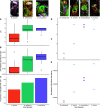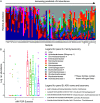Carnivorous Nepenthes Pitchers with Less Acidic Fluid House Nitrogen-Fixing Bacteria
- PMID: 37338413
- PMCID: PMC10370301
- DOI: 10.1128/aem.00812-23
Carnivorous Nepenthes Pitchers with Less Acidic Fluid House Nitrogen-Fixing Bacteria
Abstract
Carnivorous pitcher plants are uniquely adapted to nitrogen limitation, using pitfall traps to acquire nutrients from insect prey. Pitcher plants in the genus Sarracenia may also use nitrogen fixed by bacteria inhabiting the aquatic microcosms of their pitchers. Here, we investigated whether species of a convergently evolved pitcher plant genus, Nepenthes, might also use bacterial nitrogen fixation as an alternative strategy for nitrogen capture. First, we constructed predicted metagenomes of pitcher organisms from three species of Singaporean Nepenthes using 16S rRNA sequence data and correlated predicted nifH abundances with metadata. Second, we used gene-specific primers to amplify and quantify the presence or absence of nifH directly from 102 environmental samples and identified potential diazotrophs with significant differential abundance in samples that also had positive nifH PCR tests. Third, we analyzed nifH in eight shotgun metagenomes from four additional Bornean Nepenthes species. Finally, we conducted an acetylene reduction assay using greenhouse-grown Nepenthes pitcher fluids to confirm nitrogen fixation is indeed possible within the pitcher habitat. Results show active acetylene reduction can occur in Nepenthes pitcher fluid. Variation in nifH from wild samples correlates with Nepenthes host species identity and pitcher fluid acidity. Nitrogen-fixing bacteria are associated with more neutral fluid pH, while endogenous Nepenthes digestive enzymes are most active at low fluid pH. We hypothesize Nepenthes species experience a trade-off in nitrogen acquisition; when fluids are acidic, nitrogen is primarily acquired via plant enzymatic degradation of insects, but when fluids are neutral, Nepenthes plants take up more nitrogen via bacterial nitrogen fixation. IMPORTANCE Plants use different strategies to obtain the nutrients that they need to grow. Some plants access their nitrogen directly from the soil, while others rely on microbes to access the nitrogen for them. Carnivorous pitcher plants generally trap and digest insect prey, using plant-derived enzymes to break down insect proteins and generate a large portion of the nitrogen that they subsequently absorb. In this study, we present results suggesting that bacteria living in the fluids formed by Nepenthes pitcher plants can fix nitrogen directly from the atmosphere, providing an alternative pathway for plants to access nitrogen. These nitrogen-fixing bacteria are only likely to be present when pitcher plant fluids are not strongly acidic. Interestingly, the plant's enzymes are known to be more active under strongly acidic conditions. We propose a potential trade-off where pitcher plants sometimes access nitrogen using their own enzymes to digest prey and at other times take advantage of bacterial nitrogen fixation.
Keywords: carnivorous plant; convergent evolution; microbial ecology; nitrogen fixation; symbiosis; trade-off.
Conflict of interest statement
The authors declare no conflict of interest.
Figures



Similar articles
-
Secreted pitfall-trap fluid of carnivorous Nepenthes plants is unsuitable for microbial growth.Ann Bot. 2013 Mar;111(3):375-83. doi: 10.1093/aob/mcs287. Epub 2012 Dec 21. Ann Bot. 2013. PMID: 23264234 Free PMC article.
-
Fluid physico-chemical properties influence capture and diet in Nepenthes pitcher plants.Ann Bot. 2015 Mar;115(4):705-16. doi: 10.1093/aob/mcu266. Epub 2015 Feb 11. Ann Bot. 2015. PMID: 25672361 Free PMC article.
-
Comparative Study of Bacterial Communities in Nepenthes Pitchers and Their Correlation to Species and Fluid Acidity.Microb Ecol. 2016 Aug;72(2):381-93. doi: 10.1007/s00248-016-0798-5. Epub 2016 Jun 10. Microb Ecol. 2016. PMID: 27287538
-
Traps of carnivorous pitcher plants as a habitat: composition of the fluid, biodiversity and mutualistic activities.Ann Bot. 2011 Feb;107(2):181-94. doi: 10.1093/aob/mcq238. Epub 2010 Dec 15. Ann Bot. 2011. PMID: 21159782 Free PMC article. Review.
-
Carnivorous pitcher plants: insights in an old topic.Phytochemistry. 2011 Sep;72(13):1678-82. doi: 10.1016/j.phytochem.2010.11.024. Epub 2010 Dec 22. Phytochemistry. 2011. PMID: 21185041 Review.
Cited by
-
Analysis of the northern pitcher plant (Sarracenia purpurea L.) phytotelm bacteriome throughout a temperate region growing season.PLoS One. 2024 Jul 12;19(7):e0306602. doi: 10.1371/journal.pone.0306602. eCollection 2024. PLoS One. 2024. PMID: 38995889 Free PMC article.
References
-
- Berendse F, Aerts R. 1987. Nitrogen-use-efficiency: a biologically meaningful definition? Funct Ecol 1:293–296.
-
- Givnish TJ, Burkhardt EL, Happel RE, Weintraub JD. 1984. Carnivory in the bromeliad Brocchinia reducta, with a cost/benefit model for the general restriction of carnivorous plants to sunny, moist, nutrient-poor habitats. Am Nat 124:479–497. doi:10.1086/284289. - DOI
-
- Chapin CT, Pastor J. 1995. Nutrient limitations in the northern pitcher plant Sarracenia purpurea. Can J Bot 73:728–734. doi:10.1139/b95-079. - DOI
-
- Plummer GL, Jackson TH. 1963. Bacterial activities within the sarcophagus of the insectivorous plant, Sarracenia flava. Am Midl Nat 69:462–469. doi:10.2307/2422922. - DOI
Publication types
MeSH terms
Substances
LinkOut - more resources
Full Text Sources

